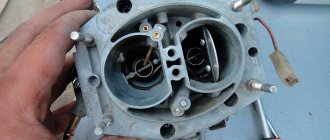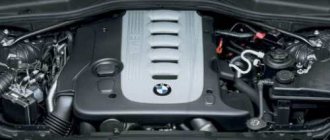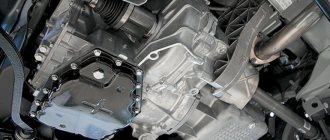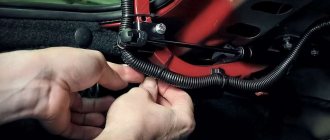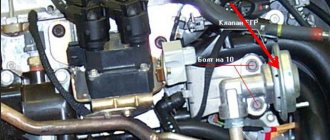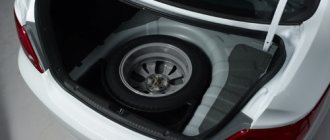It was an ordinary winter Friday morning (not the 13th), nothing foreshadowed trouble... I open the car, get behind the wheel, turn on the ignition and, after waiting for the gas pump to buzz, I start the engine. Having started, the engine begins to vibrate strongly, and in the instrument cluster it first blinks several times, and then the Check Engine lights up...
Having removed the engine screen, I found Torxes securing the coils. The existing head does not fit a half-inch square... I had to run to the nearest TAZ parts store, fortunately it is not far from my garage. I hooked the head under a ¼-inch square, along with a candle holder with a magnetic holder, and ran back to the garage. I took off the coils and turned out the spark plugs. I wanted to check the gaps on the new spark plugs, but I lost all the feeler gauges somewhere... Okay, I don’t have time, I’ll check it later. I sprayed the threads with graphite, covering the electrodes with tubes from a package of spark plugs, and wrapped the spark plugs without a torque wrench. I put on the coils, start the engine and, lo and behold, the engine started working smoothly! Feet in hand and follow a friend and strike a chord. The Check Engine went out only the next day, although there were no longer any deviations in engine operation:
Another entertaining sketch. I’m complaining on the phone to a friend about the early failure of the spark plugs. A friend says, look, is there any oil in the spark plug wells? I say, “Danunah”, where does he come from?! But when checking the gaps, I decided to shine a flashlight into the wells. And what do you think I found there? That's right, oil fogging... “This is normal, it happens to everyone!” — I remembered the words of the employees of OD LADA, with which they “reassured” me when applying for a warranty. Knowing about the peculiarities of VATOVAZ’s “warranty policy”, you should go to the OD with this joint only when the oil starts gushing out from under the coils... By the way, spark plugs are consumables, there is still no guarantee for them. In general, I washed the wells with nefras, blew them with compressed air, and turned the Torchi on with a torque of 30 Nm. Perhaps my organ will still travel. Moreover, “it’s like this for everyone.”
The engine air filter was also replaced, which I wanted to change after TO-1, but I never got around to it.
On cars of the Lada Vesta family, one of the most common problems is considered to be jerking of the car, which can manifest itself when releasing the gas, driving at low speeds and when changing gears. The problem has been discussed since the first appearance of the Lada Vesta on the Russian market and occurred on models with 1.6 and 1.8 liter engines.
In search of a solution to the jerking, procedures such as adapting the throttle and adjusting the clutch sensor using improvised means were carried out. Unfortunately, none of them was a universal solution; some owners spoke about improving the behavior of the car, but the twitching was not completely eliminated.
A couple of days ago, another method of combating this phenomenon appeared, its author turned out to be the owner of the YouTube channel “Pod kapot”. He suggested that there was insufficient insulation of the adsorber fitting at the junction with the tube (see photo above), as a result of which air was leaked into the system and its operating pressure changed. To solve this problem, it is proposed to use o-rings that are used in the water supply system. You can modify your Lada Vesta yourself, spending just a few minutes on it.
First of all, we go to the plumbing store and buy six o-rings, as in the photo above. Such rings are used to supply water to household faucets. The diameter of the adsorber fitting is 8 millimeters, the same value should be for the internal diameter of the sealing ring. Be careful, rings come in different thicknesses, it is advisable to choose one that is as similar as possible to what is shown in the photo above.
- Disconnect the tube from the adsorber, as shown in the photo above (to disconnect, press two buttons on the end of the tube)
- Install the O-rings (3 pieces on the adsorber fitting and the remaining 3 on the other side of the tube)
- Place the tube in place until you hear a characteristic click.
On most Lada Vestas with a 1.8 liter engine, this method gave an amazing effect and eliminated the twitching almost completely. But the opinions of the owners of the Lada Vesta with an engine capacity of 1.6 liters are divided, some say that there is an effect, while others deny it. The fact is that on cars with a 1.6 liter engine the tube is installed before the absolute pressure sensor (MAP), and on the Lada Vesta with 1.8 the tube is installed after the MAP.
If you have already carried out this procedure on your Lada Vesta, tell us in the comments about its results, did you manage to eliminate the twitching?
Came to help. I saw that the “Check” was on, plugged in the ELM327 v1.5, which I had in advance in the glove compartment, and quickly installed something on the Android phone. I saw two errors (see photo, misfire in cylinder 3). Started it up. It doesn't triple anything. I cleared the errors, drove for a drive, the check light no longer came on. I examined the spark plug wells of cylinders 2 and 3. I cursed at the star bolts that secure the ignition coils (but unscrewed them with a regular hex head). I vented and inspected the spark plug in cylinder 3. The spark plugs are Russian, they still look the same, but they can be replaced with NGK ones. I did not find any oil leaks in the spark plug wells. The coils of cylinders 2 and 3 were swapped. If the coil fails, then misfires in the future will occur in another cylinder. Everything works, although according to my wife it was impossible to drive before and trying to turn off/start the engine did not have a positive effect.
We'll have to watch some more. What it was - I'm at a loss. On Kalina 1.4 with a 16kL engine, this hasn’t happened in 10 years (although somehow oil was discovered in the spark plug well and repairs had to be made).
If anyone has had something similar, I ask for advice.
Vibration, tripping, failures during engine operation
On owner forums, cases of engine vibration and tripping, failures during acceleration and inadequate response to pressing the gas pedal are often described. And almost always a continuation follows: the dealer did not see the fault, citing bad gasoline. Indeed, the situation for motorists is difficult.
It remains for Vest owners to experiment on their own in an effort to rid the car of the disease: change gas stations and types of gasoline, spark plugs, coils, firmware. Our sedan avoided the problem.
Scratched glass
Another problem for Vesta, which appeared immediately after the start of sales. Vertical scratches appeared on the side windows in just a few lifting and lowering cycles. It was all blamed on the door seals being too rigid and too close together.
Dealers cut them and changed them, but, according to our observations, it helped little. Judging by the number of abrasions and small chips on the windshield of the editorial car, Vesta uses too “soft” glass. But here the plant did not make any changes: they continue to install the same Sisecam on the cars.
The right way
Finally, they gave me some good advice: check the tube between the canister valve and the intake manifold. In fact, a large vacuum is created in the starting system. If there is air leaks in the tubes, the fuel mixture will become lean. As a result, the engine will jerk.
I checked the fitting of this tube at the entrance to the manifold - it was loose.
At the second end of the hose, the same thing happens - the fitting moves and is not seated tightly.
The adsorber itself, which is made in the form of a white fungus (visible below in the photo), sucks air from the atmosphere. Due to the vacuum in the intake manifold, gasoline vapors are sucked into the intake system through the canister ventilation valve.
There is a green rubber ring installed in the fitting. It should seal the connection well. To check the quality of the seal, we had to conduct an experiment.
Messages 11
1 Topic by Axel 2016-01-27 14:51:44
- Axel
- Participant
- Inactive
- Posts: 973
Topic: Gas pedal failure Lada Vesta
The first “glitch” appeared on about the third day - the gas pedal did not work! I stopped, turned it off, then started it again and everything became normal... I gave the car to my father and he had the same problem. I didn’t contact the dealer because I was away on a business trip...
The most interesting things began after my arrival. So I pulled the car out of the garage, drove to the village (15-20 km) and on the way back the same story - I press the pedal and there is zero emotion! I stopped, turned it off, started moving again and after 50 meters the same story... Somehow I made it to the parking lot of a local store. There the story became even more fun. I started the car and at idle it began to shake, the revolutions began to drop to 500, then the car stalled. I had to take it to the dealer with a tow truck.
At the service center, Vesta started up without any problems and everything was fine. I drove around the city with the master, who until recently did not understand what kind of problems I had. However, after a kilometer and a half, history repeated itself. Here the master himself got behind the wheel and felt the problem. The car had to be pulled back to the dealers by a cable.
There, after about an hour and a half or two hours of waiting, I was informed that all systems were normal and no errors had been identified. Let's go for a ride again. This time, it’s not clear why, everything was fine. They said the problem was only in gasoline... But what about gasoline?! I only refuel with Lukoil and Rosneft 95 gasoline...
In general, they sent me home until the next breakdown, without returning the money spent on a tow truck... But how to drive?! Imagine if you need to avoid a collision or if you overtake a truck on the highway and the gas stops... It’s somehow scary...
They say that this is the first case noticed, but maybe someone had something similar? Share - I will be glad!
2 Reply from Ronnikkee 2016-01-27 15:28:27
- Ronnikkee
- Participant
- Inactive
- Posts: 36
- Thanks: 7
They said the problem was only in gasoline... But what about gasoline?! I only refuel with Lukoil and Rosneft 95 gasoline...
Judging by the sign it looks like gasoline. And refueling here does not mean that the gasoline is of high quality, anything can happen.
In general, they sent me home until the next breakdown, without returning the money spent on the tow truck...
If it happens again with other gasoline, then the problem will still be diagnosed and the money will be returned, maybe)
Stabilizer bushings creaking
This is perhaps the first mass criticism of the brand new Vesta. The cars began to be sold at the end of November 2022, and even before 2016 began, unflattering reviews began to pour in.
At first, dealers lubricated the squeaking rubber bands, then the factory offered a replacement. Which, by the way, still creaks for some particularly “lucky” newsreaders.
The people's ingenuity did not stand aside either. People massively selected alternative parts from foreign cars, simply focusing on similar dimensions. You can find more than a dozen different options on the Internet, from popular to elite. They didn’t experiment with the editorial machine, and at the next maintenance the dealer replaced the bushings with modernized ones under warranty. It became quiet.
Check and test
I removed the lower fitting of the adsorber valve, the plug with wires. I applied 12 volts to the valve and it opened. When I removed the throttle, I plugged the hole on the back side. He took a cigarette and lit it. When the valve was open, I blew into it. With my other hand I blocked the second channel into the intake manifold. What do you think happened? Smoke came out of the hole.
As a result, I concluded that the connections of the tube going from the valve to the intake manifold were leaking. Therefore, air is sucked in in a large volume. Everything below the canister valve does not need to be sealed. This does not affect the operation of the Lada Vesta engine, since air flows freely into the adsorber through the white fungus.
Terms of service
The knot itself can be removed anywhere. This can be done in the garage. But usually, the unit is removed near the client’s entrance. We remove the knot. Let's go home. Sharpening. We take it out, install it, check it. You don't have to drive across the city, stand in traffic jams, etc. You save a lot of time and nerves.
If you have the opportunity and your superiors, we can provide the service right at your place of work. You can drive home from work with pleasure from the way your car drives. The service can also be provided with travel to nearby settlements from the city, which can be reached by bus or train. In this case, transportation costs are added to the cost of the service. In any case, these expenses will cost you less than your arrival. You can save on transportation costs if you cooperate with someone and the service is provided to someone else besides you.
* To work you need a small table, chair and 220V.
And, of course, it is desirable that the car is clean. Or there was some kind of rag to cover the dirty fender of the car. It is also necessary to have a rag for washing the throttle.
For reference: sawdust does not fly all over the space. Metal filings don’t go anywhere beyond the newspaper.
Lada Vesta twitches, what to do
On cars of the Lada Vesta family, one of the most common problems is considered to be jerking of the car, which can manifest itself when releasing the gas, driving at low speeds and when changing gears. The problem has been discussed since the first appearance of the Lada Vesta on the Russian market and occurred on models with 1.6 and 1.8 liter engines. In search of a solution to the jerking, procedures such as adapting the throttle and adjusting the clutch sensor using improvised means were carried out. Unfortunately, none of them was a universal solution; some owners spoke about improving the behavior of the car, but the twitching was not completely eliminated.
Engine oil burner 1.8
The VAZ 1.8 engine with a power of 122 hp took a long time to reach production cars. I was upset by three things: I turned out to be not so cheerful, I was hungry for gasoline and oil. Of course, oil loss is not on such a scale as on other turbo engines, but before Lad engines were not noticed in this way in principle, and therefore the topic has become acute.
Fuel consumption in traffic jams is good for 10 l/100 km, the owners of the West 1.8 just have to come to terms with it. But AVTOVAZ indirectly acknowledged two other problems by upgrading the engine. To improve traction characteristics, the firmware was changed. Maslozhor was eliminated by a whole range of modifications to the hardware and assembly process.
There seem to be fewer complaints, but evidence of increased consumption still occurs. Those who attended a long-term test in the editorial office of Vesta with a 1.8 engine also noted this.
How to troubleshoot
All that matters to us is the ill-fated pipe in question.
The order of my actions (step by step instructions):
- I removed the wallpaper from the ends of the tube.
- I measured the diameter of the inlet pipe with a caliper: it turned out to be 8 mm.
Kits are sold by different manufacturers, and the sizes of sealing rubber bands may vary. Therefore, if you use a ring that is too thick, you may break the plastic fitting. The place where the latch is attached may also break off. I am not imposing this procedure on anyone, use the advice at your own responsibility. But it helped me solve the problem.
I tried to put the elastic band on the pipe - it stood up like a native one! Maybe AvtoVAZ forgot to install them. Of course, they are not oil resistant, but in this case this will not matter. I put the fitting on top and it was a little loose. I put on the second ring - also rather weak. Then he put on the third one.
After that I put the fitting on tightly, it turned out very tight. From the other end of the tube I performed similar procedures. Now nothing is loose. I installed a decorative engine cover.
Service cost
Moscow and region
The service is provided on site or at the address: village. Fork, 2a . The village is located outside the Moscow Ring Road along Kashirskoye Highway opposite the state farm named after. Lenin. See further down the site for the service provision period.
Ask questions to the master by phone: 8-965-321-31-01 (Beeline Moscow).
Or write to the master by e-mail:
Or use the feedback form in the lower right corner. * Write your cell phone number directly in the message. Sometimes the answer doesn’t reach you!
St. Petersburg and region
The service is usually provided on site in your territory. Description of the terms of service further down the site.
Or by writing by e-mail:
Or use the feedback form in the lower right corner. * Write your cell phone number directly in the message. Sometimes the answer doesn’t reach you!
Cheboksary
See further on the site for the provision of services in Cheboksary
You can ask him questions by phone: 8-965-321-31-01 (Beeline Moscow) 8-965-070-65-01 (Beeline Peter) WhatsApp. I can call you back from this number.
Or write to the master by e-mail:
Or use the feedback form in the lower right corner. Please include your cell phone number in your message.
Nizhny Novgorod
See further on the site for the provision of services in Nizhny Novgorod
You can ask him questions by phone: 8-965-321-31-01 (Beeline Moscow) 8-965-070-65-01 (Beeline Peter) WhatsApp. I can call you back from this number.
Or write to the master by e-mail:
Or use the feedback form in the lower right corner. Please include your cell phone number in your message.
Naberezhnye Chelny
In Naberezhnye Chelny, the service will be provided upon arrival in the city. See the schedule further down the site.
You can ask questions by phone: 8-987-406-77-07 (MTS Nab. Chelny) 8-937-57-11-007 (Megafon Nab. Chelny)
Or write to the master by e-mail:
Or use the feedback form in the lower right corner. * Write your cell phone number directly in the message. Sometimes the answer doesn’t reach you!
Ekaterinburg
See further on the site for the provision of services in Yekaterinburg The place of stay will be Pervouralsk.
You can ask questions or leave a request using feedback by e-mail:
or by phone:
8-965-070-65-01 (Beeline Peter) WhatsApp.
I can call you back from this number. Or use the feedback form in the lower right corner.
Chelyabinsk
See further on the site for the provision of services in Chelyabinsk
You can ask him questions by phone: 8-965-321-31-01 (Beeline Moscow) 8-965-070-65-01 (Beeline Peter) WhatsApp. I can call you back from this number.
Or write to the master by e-mail:
Or use the feedback form in the lower right corner.
See further on the site for the provision of services in Ufa
You can ask him questions by phone: 8-965-321-31-01 (Beeline Moscow) 8-965-070-65-01 (Beeline Peter) WhatsApp. I can call you back from this number.
Or write to the master by e-mail:
Or use the feedback form in the lower right corner.
Samara
See further on the site for the provision of services in Samara
You can ask him questions by phone: 8-965-321-31-01 (Beeline Moscow) 8-965-070-65-01 (Beeline Peter) WhatsApp. I can call you back from this number.
Or write to the master by e-mail:
Or use the feedback form in the lower right corner.
See further on the site for the provision of services in Tula
You can ask him questions by phone: 8-965-321-31-01 (Beeline Moscow) 8-965-070-65-01 (Beeline Peter) WhatsApp. I can call you back from this number.
Or write to the master by e-mail:
Or use the feedback form in the lower right corner.
Voronezh
See further on the site for the provision of services in Voronezh
You can ask him questions by phone: 8-965-321-31-01 (Beeline Moscow) 8-965-070-65-01 (Beeline Peter) WhatsApp. I can call you back from this number.
Or write to the master by e-mail:
Or use the feedback form in the lower right corner.
Rostov-on-Don
See further on the site for the provision of services in Rostov
You can ask him questions by phone: 8-965-321-31-01 (Beeline Moscow) 8-965-070-65-01 (Beeline Peter) WhatsApp. I can call you back from this number.
Or write to the master by e-mail:
Or use the feedback form in the lower right corner.
Krasnodar
See further on the site for the provision of services in Krasnodar
You can ask me questions by phone: 8-965-321-31-01 (Beeline Moscow) 8-965-070-65-01 (Beeline St. Petersburg) WhatsApp. I can call you back from this number.
Or write to the master by e-mail:
Or use the feedback form in the lower right corner.
Novorossiysk
See further on the site for the provision of services in Novorossiysk
You can ask me questions by phone: 8-965-321-31-01 (Beeline Moscow) 8-965-070-65-01 (Beeline St. Petersburg) WhatsApp. I can call you back from this number.
Or write to the master by e-mail:
Or use the feedback form in the lower right corner.
Anapa
See further on the site for the provision of services in Anapa
You can ask me questions by phone: 8-965-321-31-01 (Beeline Moscow) 8-965-070-65-01 (Beeline St. Petersburg) WhatsApp. I can call you back from this number.
Or write to the master by e-mail:
Or use the feedback form in the lower right corner.
Penza
See further on the site for the provision of services in Penza
You can ask me questions by phone: 8-965-321-31-01 (Beeline Moscow) 8-965-070-65-01 (Beeline St. Petersburg) WhatsApp. I can call you back from this number.
Or write to the master by e-mail:
Or use the feedback form in the lower right corner.
Ulyanovsk
See further on the site for the provision of services in Ulyanovsk
You can ask him questions by phone: 8-965-321-31-01 (Beeline Moscow) 8-965-070-65-01 (Beeline Peter) WhatsApp. I can call you back from this number.
Or write to the master by e-mail:
Or use the feedback form in the lower right corner.
Tambov
See further on the site for the provision of services in Tambov
You can ask him questions by phone: 8-965-321-31-01 (Beeline Moscow) 8-965-070-65-01 (Beeline Peter) WhatsApp. I can call you back from this number.
Or write to the master by e-mail:
Or use the feedback form in the lower right corner.
Saratov
See further on the site for the provision of services in Saratov The place of stay will be Tatishchevo.
You can ask him questions by phone: 8-965-321-31-01 (Beeline Moscow) 8-965-070-65-01 (Beeline Peter) WhatsApp. I can call you back from this number.
Or write to the master by e-mail:
Or use the feedback form in the lower right corner.
Tolyatti
See further on the site for the provision of services in Tolyatti
You can ask me questions by phone: 8-965-321-31-01 (Beeline Moscow) 8-965-070-65-01 (Beeline St. Petersburg) WhatsApp. I can call you back from this number.
Or write to the master by e-mail:
Or use the feedback form in the lower right corner.
The owners named two reasons for the “jerking” of the LADA Vesta SW Cross when starting off
Read more: How to remove the crankshaft pulley Renault Logan External and internal CV joints
The next reason why the car jerks when starting off may be the inner and outer CV joints. Internal CV joints transmit forces from the box to the car's axle shafts, and then to the wheels, which makes them quite important elements in the suspension system. Considering that these parts are systematically subjected to heavy loads, they may fail. The presence of a malfunction can be determined by the following signs: The CV joint turns when starting to move, there is play. Because of this, the car may jerk when starting from a stop. On the road, the CV joint may knock. Moreover, the road can be perfectly smooth. When turning, you can hear the crunch of the outer CV joints; when they wear out, they can also turn and create jerks when the car starts moving. Outer CV joints most often fail due to driving on bad and uneven roads. It follows that the first malfunction, due to which the car jerks when starting off, can be the CV joints. They are the first to be checked at a service station when a driver contacts a mechanic with a similar problem. Replacing these elements is quick, easy and most often does not cost a lot of money if we are talking about a domestic car and not a rare foreign car. Moreover, some car owners can replace the CV joints themselves; for this you will need a pit in the garage, a small set of tools and new CV joints, which are sold in almost any car store.
The second possible reason is the checkpoint. But if the gearbox is not completely working, then you can also observe other manifestations besides jerks at the start: difficulty shifting any gear, noise from the unit, etc. If we are talking about a manual gearbox, then its repair can be inexpensive . It is difficult to replace any gear in such a mechanism, but it is possible, and this is something that specialists at service stations undertake. If the automatic transmission malfunctions, the situation becomes more complicated. Repairing it will be expensive. If the variator in an automatic transmission begins to jerk, then the service station most often offers its complete replacement, since repair in this case is impractical. It is difficult to diagnose a problem that causes the car to jerk when starting off on your own. This can only be revealed by service station specialists during a detailed inspection of the car and its components.
If the steering rack is faulty, it may well jerk when starting to move. Worn elements of this mechanism are usually not repaired - they are replaced with new ones. Also, the tips of the steering rack can dangle freely in their positions, which will cause jerks when accelerating sharply and when braking. In this case, the steering wheel wobbles. Damage to the steering column cannot be ruled out (usually this occurs in an accident), which can also create jerks when moving or starting.
Where do the savings come from?
A four-cylinder engine makes four strokes in one full cycle. On the first stroke, fuel is always supplied. A modified throttle makes the fuel mixture better. Due to which it burns better. Because of this, the engine torque increases. And the car becomes more dynamic at low speeds. After a short dynamic acceleration, switch to a higher gear. Due to this, the speed is reduced. And the number of first measures decreases. That is, less fuel is supplied. On some cars, the ECU also reduces the amount of fuel supplied.
Refinement of a new electronic gas pedal
The pedal assembly (11183-1108500-01) does not have oval holes, which does not allow adjustment in the manner described above. Instead, it is proposed to cut off the protrusion (by 2-3 mm), which prevents the pedal from moving completely. This modernization made it possible to increase the pedal travel, which made acceleration with “pedal to the floor” more active. It is also noted that there is no hesitation when pressing the pedal sharply.
What I don’t like about the pedal assembly (8450008980), which is installed on Lada Vesta:
- tight gas pedal;
- large free play of the gas pedal (about 8 mm at the tip of the pedal).
What was decided to do:
- remove one of the return springs to make the pedal softer;
- Place a spacer to reduce the free play of the pedal.
How to measure pedal free play:
- Let's start the engine.
- Place a ruler at the tip of the pedal.
- Smoothly press the pedal until the engine begins to gain speed.
- We remember the distance on the ruler.
We remove and disassemble the electronic gas pedal:
- Disconnect the connector (by pressing the inside of the upper part of the latch)
- Unscrew three nuts (head “10”).
- Remove the top cover by unscrewing the fastening screws.
- Remove the rheostat slider by unscrewing the screw.
- Remove the spring (holding them with a screwdriver from the outside).
- Remove the white support spacers, remembering how they were installed.
- We measure the distance between the support pad of the return spring lever and the support rubber in the body, retracting the pedal to the amount of free play (indicated by an arrow).
- We glue the material of the same thickness (in this example we use 4 mm stickers for furniture legs and doors) using glue or double-sided tape.
We assemble the pedal assembly and install it in the car. The idle motion of the pedal should be minimal, about 1 mm. If the engine idle speed is higher than usual, and there is no free play of the pedal at all, then too much has been added. You will have to repeat the adjustment operation, adjusting the thickness of the lining. The same thing applies if the free play after adjustment remains more than 1-2 mm.
Questions and answers
How did you come up with this?
I didn't invent the technology. I'm just a copyright holder. And I bring the technology to mind.
How long have you been doing this?
This is my eleventh year of professionally improving the performance of cars using mechanical modifications of the throttle. I'm not deceiving anyone and I'm not running from anyone. Deceiving people is not my specialty, and deceiving is more expensive for myself. I guarantee my work. The described changes in cars are recorded from the words of customers.
What cars have throttle modifications done on them?
Modification of the throttle is done for gasoline (injection, carburetor) engines. We use other technologies for diesel engines.
How much will the engine power increase after modifying the throttle?
The engine produces maximum power at high speeds of 4000-7000 rpm, depending on the engine. This is the indicator that is written in your documents. At low and medium speeds the engine does not produce maximum power. Using this technology, I increase power at low speeds and partly at medium speeds. And this indicator does not in any way affect the maximum engine power. Therefore, the horses remain, and traction at low speeds increases.
How can modifications to the throttle affect engine life?
Positively! The less fuel is burned, the less soot and coking of pistons and piston rings is formed. The absence of carbon deposits does not lead to other ensuing problems with the engine. It also extends the life of the car’s catalyst, if it still has one. Because unburned gasoline does not burn out in the catalyst. After modifying the throttle, you start driving at lower speeds. Fewer revolutions reduce wear on engine rubbing parts. Thus, the motor life of the engine increases.
Why don't manufacturers immediately modify the throttle?
Why don’t manufacturers immediately do what the market offers to improve cars?!
Firstly, the technology is young. Secondly, the manufacturer puts into the car what the market offers. Bosch holds the lion's share of the electrical market. Therefore, this modification must be done by Bosch. Thirdly, there is information that this technology was bought by Toyota and BMW. It is possible that new car models from these manufacturers will already have this modification.
* You can see the rest of the answers to the questions at the link »» at the link »»
Light engine vibration at idle on Vesta: diagnosis of causes
Lada Vesta is equipped with one of two gasoline engines – 21129 (1.6 l.) or 21127 (1.8 l.). The control system is electronic. Initially, the operation of the computer and feedback sensors is finely tuned. However, over time, a problem arises - instability of speed at idle and while driving. Determining the exact cause is often difficult due to the fact that the Check Engine light does not light up, so scanning the ECU is useless. Still, you can identify the flaw of uncomfortable functioning on your own.
Inoperative turn signal repeaters
LED turn signal repeaters in mirror housings turned out to be unreliable. At first they were leaky and were killed by moisture getting inside. Then they began to die completely and immediately, without the help of water. Failures are recognized as covered by warranty without any problems. Now her treatment is much simpler than in the early years of West's graduation. Then we had to wait for the delivery of assembled mirrors, already painted in the color of the body: long, expensive and stupid. Now only the optical element itself is changed. Owners of out-of-warranty cars need not worry: it retails for about 500 rubles.
Rusting exhaust corrugation
The short-lived exhaust system has always been the “calling card” of domestic cars. Vesta remained faithful to tradition. The corrugation rusts very actively! For some time the sound will remain within the bounds of decency, but then it will “break through” anyway, and you will go to the service center with the roar of a fighter jet.
When it started to “hide” under our bottom, the odometer showed 38,000 km. According to the conditions in force at that time, the release was covered by a warranty for a year or 35,000 km. However, it has now been removed from the exceptions, and the owner has the right to demand a free replacement within three years or 100,000 km from the date of purchase. We took advantage of this right at a mileage of 63,000 km.
Poor hood seal
For the first year and a half, Vestas were fitted with a hood seal of two halves with a gap in the center near the lock. It was there that dirt broke through under the hood in huge quantities. Over 15–20 thousand km, the engine compartment becomes suitable for planting vegetables.
Later the plant switched to solid rubber. The trouble is that in the central part it is still not glued. The rate of contamination of the engine compartment has decreased, but has not become zero. Lovers of cleanliness still need to do “collective farm” work in every nook and cranny of the car. And not only them: Vesta is so dirty in this part that even checking the oil level is unpleasant.
- A wide range of auto chemicals and many useful car accessories can be found on the pages of the Za Rulem store.
Why are the revs dropping?
There are many reasons that can provoke failure when pressing the gas pedal. This circumstance significantly complicates diagnosis.
- Spark plugs and high voltage wires are the first thing you need to pay attention to when this problem occurs. The problem with spark plugs is carbon deposits that occur during vehicle operation. Carbon deposits cause incorrect operation of the spark plugs, which in turn leads to engine failure. Wires do not often become the cause of such a malfunction, but still their condition is also checked without fail. During the diagnostic process, a fracture or poor contact may be detected.
Carbon deposits on spark plugs
Many car enthusiasts who drive a LADA Vesta are faced with the fact that the car begins to “twitch” when slowing down or adding gas. The owner of this model told how he managed to get rid of this problem.
A car owner's concern about LADA Vesta at low speeds can be easily fixed in just five minutes. As the motorist said, he tried a lot of advice he read on the Internet, but the problem is “cured” by adapting the throttle.
“Job on jamb”: Autoblogger found more than 20 shortcomings in LADA Vesta
A fresh review of the LADA Vesta model has appeared on the Internet, in which an autoblogger counted 21 shortcomings in this car.
As the motorist explained, the “twitching” appears due to the fact that the car is equipped with an adaptive throttle, which adapts to the driver’s driving style. There is no need to carry out such a “ritual” before each trip, but when replacing or cleaning the throttle it is worth repeating. However, this method also has a drawback: the car began to “eat” a little more fuel.
Several reviews on other cars
UAZ Patriot , 2.7 l., 2009 It became easy to move and accelerate. Especially for maneuverability. Became like a good foreign car. The car is unrecognizable, it rolls in such a way that it is not inferior to any foreign car. I like to ride. Alexander
The first impressions of car owners after the service on a UAZ Patriot.
Your browser does not support video. Please use another browser.
Good afternoon Vladislav. Today I received a parcel with a throttle and immediately installed the unit. The car is unrecognizable. The Volga , weighing 1.8 tons, tears from a stop with slipping through our mountains , where it used to go in 3-4 gears, now it is free in 5th and is still accelerating . At the old node the speed is 90 km. accelerated at 3000-3300rpm. Now 2000-2300rpm. It's fun to overtake, there's no need to switch to a lower gear . And at the same time I barely press the gas pedal. So far I'm very pleased with the result.
Sincerely, Valentin Borzov (Sevastopol)
The first sensations of the car owner after the service on the Mitsubishi Pajero-4 manual transmission 3l.
Your browser does not support video. Please use another browser.
Reviews on various forums
The throttle assembly has been modified. From service to home I really enjoyed the ride. No more pressing on the pedal. Just put your foot down and the car GOES. At the bottom he boldly undermines. The deep, blunt hole disappeared when the speed increased from 70 to 100 km/h. And consumption has dropped further, by 0.5 liters so far. Thank you so much for a job well done. Super. After modifications, the car actually DRIVES even with air conditioning!
